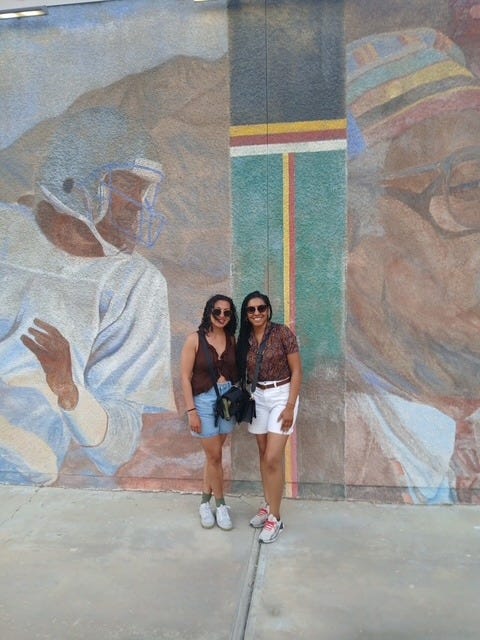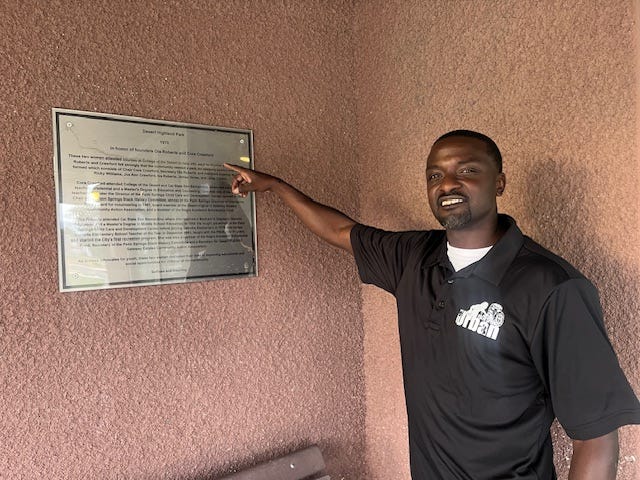We write this in honor of Juneteenth—the day in 1865 when enslaved people in Galveston, Texas, were finally informed of their freedom, more than two years after the Emancipation Proclamation was issued. Many Black families in Palm Springs trace their roots to Texas, Mississippi, and Louisiana, having arrived in California during the Great Migration. Palm Springs stands as a study in the complex realities Black communities faced after slavery.
—
We (Shellie and Nicole) embarked on the Some Context 2025 retreat—a much-needed space to talk about strategic planning and the ways we collaborate as a team. During this time, we aligned on justice as a core value for both of us. Given this shared value, it made sense to ground ourselves in the history of the local people and land.
Enter Deiter Crawford and the Palm Springs Black History Tour. Nicole came across Urban Palm Springs and Deiter Crawford somewhere in the virtual space—between Hood Century Modern and ongoing reparations conversations. Beneath the glitz and glamour of Palm Springs lies a history of displacement and racism by design.
The Tour
It was late May, and the Palm Springs heat hovered in the upper 90s . We hopped into Deiter’s tour van to begin the Palm Springs Black History Tour grateful for comfortable seats and strong air conditioning. Deiter is incredibly knowledgeable, with deep roots in Palm Springs. He sets a warm, conversational tone from the start. His pride in his community and work is palpable. As we drive past friends and family, he rolls down the windows to greet them, sharing that he’s leading a Black history tour. It’s clearly a tight-knit community that uplifts and supports one another. We roll down our windows to say hi and are greeted with warmth – genuine appreciation that we are taking the time to learn about their community, which is so often left out of the Palm Springs narrative.
The tour begins at Section 14 of the Agua Caliente Indian Reservation, where Black people first settled in the 1940s—the only place Black people were allowed to live when they arrived from the South during the Great Migration. There is a powerful sense of solidarity: the Agua Caliente Band of Cahuilla Indians welcomed Black families to live on reservation land, as deed restrictions made it illegal for Black people to reside in white neighborhoods.
The tribe uses federal, state, local, and county grants to build subsidized housing, leasing land though not owning the buildings. Some of this land is also used for casinos, cultural centers, and other development. Today, the tribe is one of the largest economic contributors in the Coachella Valley.
We are always on Native Land, as this entire country is Native Land, but to be on this land that is formally still owned by The Agua Caliente Band of Cahuilla Indians was powerful, especially because this history has been buried. The Agua Caliente Band of Cahuilla Indians own 31,500 acres of land throughout Palm Springs, the neighboring cities of Cathedral City, Rancho Mirage, as well as land in the unincorporated Riverside County area.
While the tribe leased land to Black and Mexican families, they were later pressured to evict them as Palm Springs became a vacation destination for wealthy Los Angeles tourists. Land leases evolved from five to 99 years, attracting developers. In the 1960s, city leaders forcibly removed Black and Latino families to make way for commercial development. Deiter shares heartbreaking stories of families returning home from work or school to find their belongings thrown in the street and their houses burned to the ground.
Further, Deiter explains how Black and Mexican people who built the iconic Palm Springs-style homes weren’t allowed to live in them. If they used leftover supplies to build their own homes or churches, the city would claim they were “not up to code” and bulldoze them. More than 200 homes were destroyed—despite being built by the very hands and methods that shaped the Palm Springs aesthetic.
This violent forced removal and destruction of property would be the current grounds for reparations: The city’s final cash offer was $5.9 million in direct compensation, far from the $2 billion that the roughly 300 survivors and descendants had sought. The families settled because they thought it was the best they could do, especially given the current political context.
Desert Highland Gateway Estates & Architecture
We learned about Lawrence Crossley, a visionary developer and city planner who arrived in Palm Springs in the 1920s. He was the first known Black landowner in Palm Springs. At Crossley Corners mobile park, we learned about the community’s fight to remove a towering wall of tamarisk trees—a non-native, invasive species planted as a barrier to segregate the neighborhood and make Black and brown residents invisible. Many still see the trees as an enduring symbol of racism.
We paused at the historic Tennis Club addition to see the reddish-brown Town & Country Center (1949), designed by renowned Black architect Paul R. Williams. Born in 1894, Williams became known for his work across Southern California, including designing the iconic LAX Theme Building. The beautiful mixed-use Town & Country Center is currently fenced off, awaiting an extensive renovation.

Williams, sometimes called the “Michael Jordan of Black architects,” perfected the art of sketching upside down. He learned to do this because many white clients were uncomfortable sitting next to a Black man. Sketching from across the desk allowed his clients to see his designs right-side-up without having to sit beside him.
Final Leg of the Tour
Deiter pulls out a small lunch cooler stocked with water and snacks—another gesture that speaks to the care and thoughtfulness he brings to this experience. We grab water bottles and fruit snacks.
We arrive at Desert Highland Gateway Estates—Palm Springs’ largest predominantly Black neighborhood. The tour ends at the James O. Jessie Recreation Center, a multi-use facility with a gym, computer lab, meeting rooms, and a 10-acre park. The hum of dirt bikes carries youth in loops around friends chatting and laughing on field.
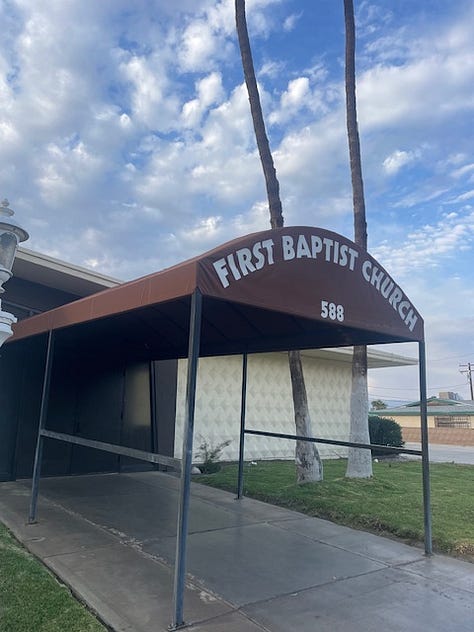
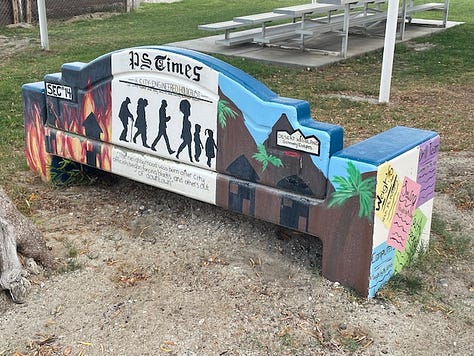
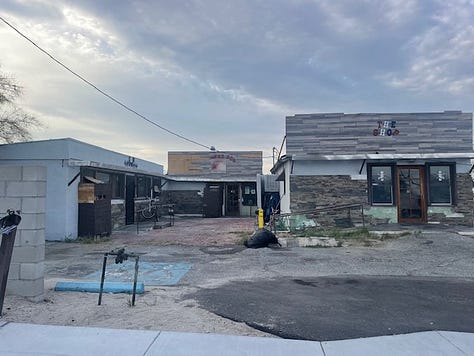
Activities here include after-school programs, senior programming, and community events. Deiter’s grandmother, Cora Crawford, founded the center; her name gleams on a plaque at the front entrance. As we pause to admire it, we can see Deiter’s pride in her legacy and the impact she had on the community. He poses for a photo pointing to her name.
The wind picks up as we watch several dirt bikes roar into the distance, the summer sun lowering behind them. We head back to where the tour began, processing all we’ve learned and feeling grateful to learn from community historians like Deiter.
—
California is often seen as a liberal oasis—someplace to escape ignorance and racism. Yet beneath that image lie buried and denied injustices that help uphold the state’s moral superiority. This history is marked by state-sanctioned housing discrimination, brutal displacement, and systemic erasure. It reminds us that places imagined as leisurely escapes—like Palm Springs, Puerto Rico, or Jamaica—are often built and sustained through exploitation and violence.
And yet, through the dust and heat, there is a story of solidarity—communities navigating settler colonialism, caring for each other, while forging spaces of possibility, creativity, and resistance.
—
We highly recommend taking the Palm Springs Black History Tour. Visit their website to learn more.






